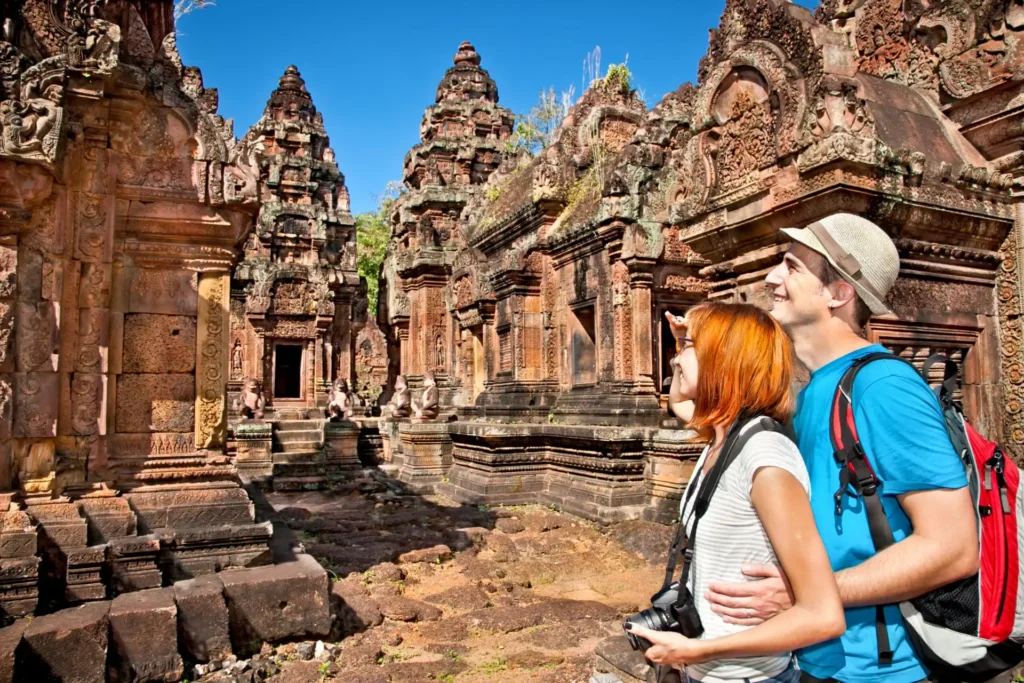
The best time to visit Cambodia: The ultimate guide
Cambodia is a destination that captures the hearts of travellers with its rich history, stunning landscapes, and vibrant culture.
If you’re already thinking about the best time to visit Cambodia, you know that deciding when is crucial. Especially to experience this magical country at its finest.
Whether it’s temples, beaches, or city life, timing your trip can significantly enhance your experience.
In this comprehensive guide, we’ll navigate through the essentials of travel to Cambodia. From understanding Cambodia currency to selecting the perfect places to visit.
So, pack your bags and prepare for an unforgettable journey. Let’s dive into the details of travelling to Cambodia so you can make the most of your visit.
Why timing matters when visiting Cambodia
When you plan a trip, knowing the best time to visit Cambodia can make a huge difference. Cambodia’s weather changes a lot over the year.
This means some times are better for visiting than others. It may be important to see Cambodia’s tourist attractions, but it is also about enjoying your time there.
Bad weather can spoil outdoor plans. Good weather makes your trip better. That’s why it’s essential to consider the best time to travel to Cambodia.
But it’s not all about weather. Festivals and events only happen only at certain times. If you visit at the right time, you can join in on these special events.
So, timing is key. It affects everything from what you can do to how much you enjoy your trip.
Keep reading to uncover more about the best time of year to visit Cambodia and how to make the most of your journey!
Buy your riels now
Cambodia’s seasons explained
Cambodia has two main seasons: the dry season and the wet season. Each season offers different experiences for visitors.
Dry season (November to April)
- This is often seen as the best time to visit Cambodia.
- The weather is sunny and dry, making it great for exploring.
- You can see famous places to visit in Cambodia, like Angkor Wat, without worrying about rain.
- The dry season is busy, so expect more tourists and higher prices.
Wet season (May to October)
- The rain brings life to Cambodia’s nature making it greener and more lush.
- This season is quieter, so it’s easier to find peaceful spots.
- Some rural areas can be hard to reach because of the rain.
- If you are okay with getting wet, visiting Cambodia in the wet season can be a unique experience.
Remember, the weather can affect your travel plans. Seek out Cambodia travel advice for the latest updates.
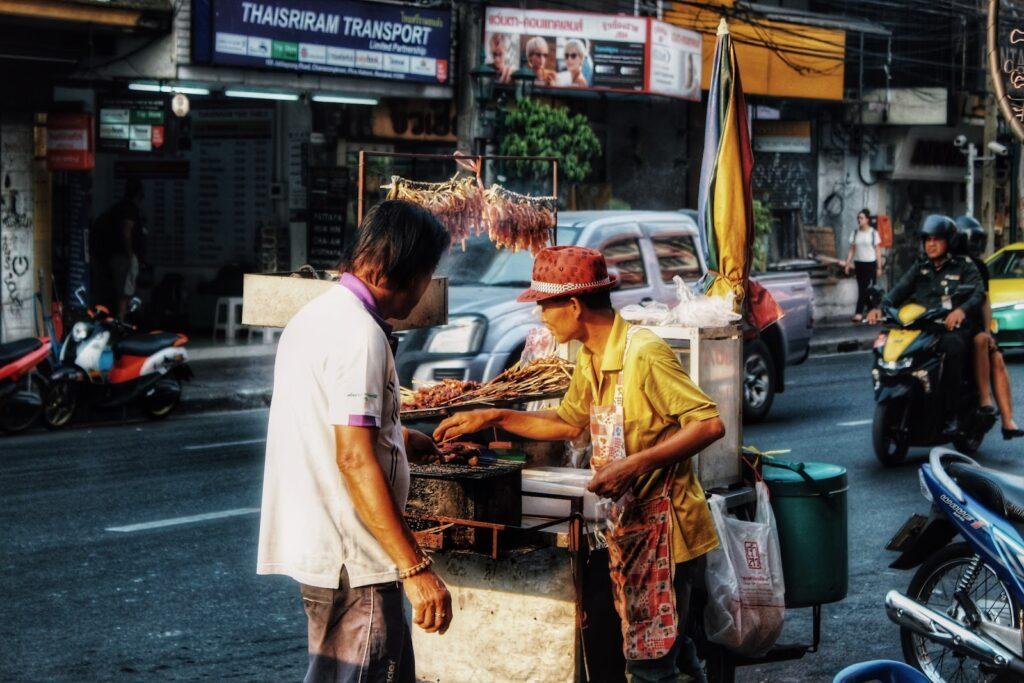
Cambodia month by month
January
- Weather: 25-31°C, minimal rainfall.
- Highlight: Ideal time for Angkor Wat; less crowded and pleasant climate.
- Event: Victory Day celebrations on January 7.
- Travel tip: Explore the Royal Palace in Phnom Penh without the heat.
February
- Weather: 26-32°C, around 10mm of rainfall.
- Event: Meak Bochea Day, a significant Buddhist ceremony.
- Highlight: Visit the vibrant night markets in Siem Reap.
- Travel tip: Experience cooler evenings in the highlands of Mondulkiri.
March
- Weather: 27-34°C, about 40mm of rainfall.
- Highlight: Explore the beaches of Sihanoukville before the peak heat.
- Travel tip: Visit the cooler, less crowded temples of Banteay Srei.
April
- Weather: 28-35°C, up to 70mm of rainfall.
- Event: Khmer New Year, with festivities throughout the country.
- Highlight: Join traditional games and dances during New Year celebrations.
- Travel tip: Stay hydrated and seek shade during the midday heat.
May
- Weather: 27-34°C, average rainfall of 150mm.
- Highlight: Lush landscapes in the countryside, perfect for photography.
- Event: Royal Ploughing Ceremony, marking the start of the rice planting season.
- Travel tip: Carry an umbrella or raincoat for sudden showers.
June
- Weather: 26-33°C, around 200mm of rainfall.
- Highlight: Visit the Cardamom Mountains for cooler treks and waterfalls.
- Travel tip: Plan indoor activities in Phnom Penh during heavy afternoon rains.
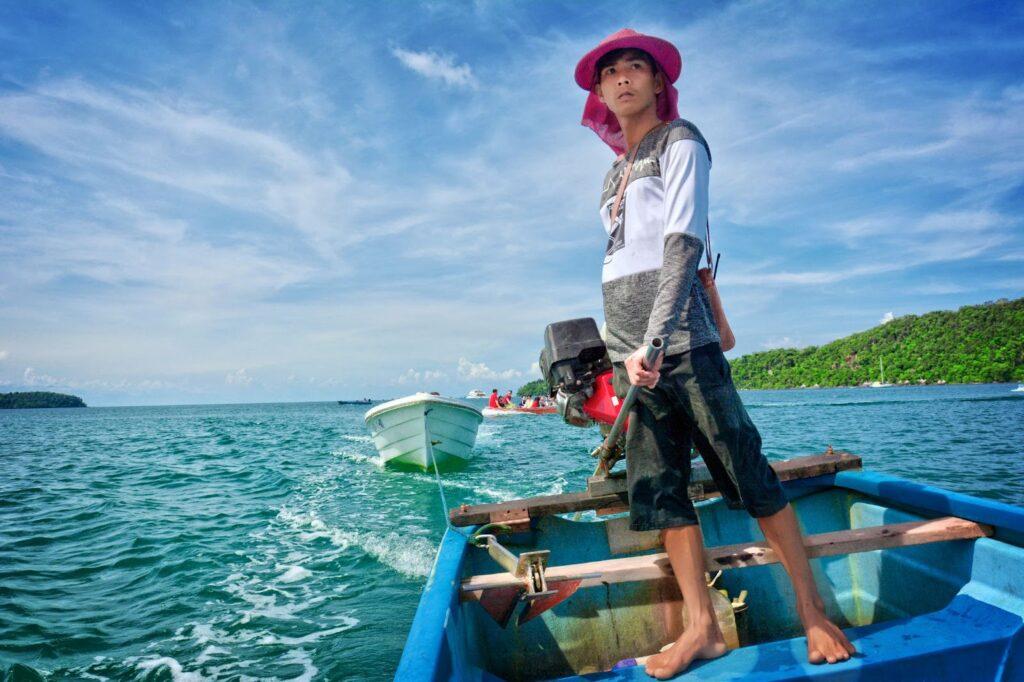
July
- Weather: 25-32°C, approximately 225mm of rainfall.
- Event: Asalha Puja Day is a religious festival with temple ceremonies.
- Highlight: See the Tonle Sap Lake at its most vibrant.
- Travel tip: Waterproof gear for temple visits is essential.
August
- Weather: 26-32°C, peak rainfall of about 250mm.
- Highlight: Experience the lush greenery of Kep and Kampot.
- Travel tip: Flexible travel plans are essential because of potential rain disruptions.
September
- Weather: 25-31°C, reducing rainfall, around 220mm.
- Event: Pchum Ben, a 15-day festival to honour ancestors.
- Highlight: Witness traditional rituals and offerings at temples.
- Travel tip: Engage with locals to learn more about Cambodian customs.
October
- Weather: 24-30°C, rainfall decreases to 140mm.
- Event: Bon Om Touk (Water Festival), with boat races on the Tonle Sap.
- Highlight: Visit the floating villages on Tonle Sap Lake.
- Travel tip: Book accommodations in advance for the Water Festival.
November
- Weather: 24-30°C, minimal rainfall.
- Highlight: Ideal time for temple tours in cooler weather.
- Event: Independence Day on November 9, with celebrations in major cities.
- Travel tip: Explore the Angkor National Museum in Siem Reap.
December
- Weather: 24-30°C, very little rainfall.
- Highlight: Perfect for beach holidays in Koh Rong.
- Event: Christmas and New Year’s celebrations in tourist areas.
- Travel tip: Enjoy outdoor dining and nightlife in Phnom Penh.

Best time for specific activities in Cambodia
Cambodia offers a diverse range of activities throughout the year. Here’s a guide to help you choose the best time for your interests:
Cultural experiences and festivals
- The best time to travel to Cambodia for cultural events is during traditional festivals like Khmer New Year (April) and Pchum Ben (September).
- January to February is excellent for exploring Cambodia’s rich history, with pleasant weather for visiting temples and museums.
Beach holidays and island visits
- For beach lovers, the best time of year to visit Cambodia is between November and March. Coastal areas like Sihanoukville, Koh Rong and Koh Rong Samloem islands are sunny and dry.
- Avoid the monsoon season (May to October) for beach activities, as heavy rains can disrupt plans.
Exploring temples and historical sites
- The ideal months are from November to February, offering cooler temperatures for visiting Angkor Wat and other archaeological sites.
- Early mornings or late afternoons are best to avoid the midday heat and crowds.
Adventure and eco-tourism
- June to August can be intriguing for trekking and exploring the lush landscapes. The countryside is vibrant and green, although trails may be muddy.
- The Cardamom Mountains and the northeastern provinces are breathtaking during this time.
Photography and nature watching
- Photographers will find May to early October rewarding, with dramatic skies and vivid greenery enhancing natural beauty.
- Birdwatching is best from December to April, especially in Prek Toal Bird Sanctuary and the Tonle Sap Lake area.
Shopping and urban exploration
- Phnom Penh, Ho Chi Minh City and other urban areas can be explored year-round.
- The dry season is more comfortable for street markets and city walks. But the wet season offers a different charm with fewer tourists.
Safety and health precautions
- Regardless of the season, it’s essential to stay updated on Cambodia travel advice and Cambodia travel restrictions.
- Always carry essentials like water, sunscreen, and mosquito repellent to ensure a safe and enjoyable experience.
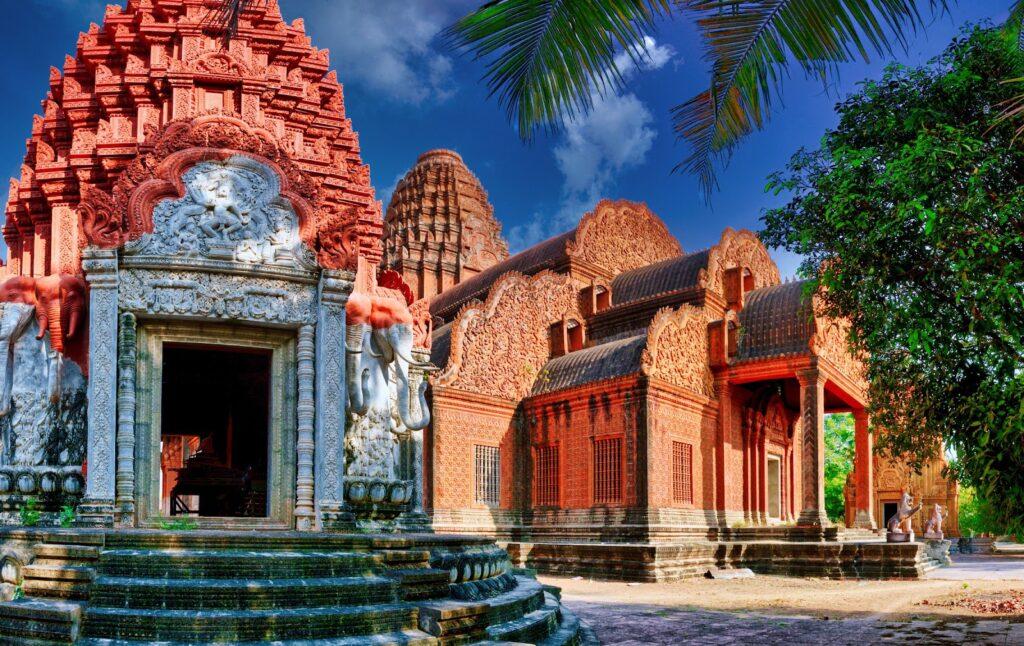
Tips for travelling in peak and off-peak seasons
Navigating through Cambodia’s peak and off-peak travel seasons requires strategic planning. Here’s how to make the most of your visit, whether you choose the bustling peak season or the tranquil off-peak months.
Peak season (November to February)
- Crowds: Expect more tourists at major sites like Angkor Wat. Arrive early to avoid the rush.
- Accommodation: Book hotels and guesthouses in advance, especially in popular areas.
- Transportation: Reserve buses, flights, and train tickets ahead of time to secure your travel plans.
- Events: Engaging in local festivals and events is a vibrant part of the Cambodian experience.
- Travel tip: Explore lesser-known places in Cambodia to escape the crowds.
Shoulder season (March to May, September to October)
- Weather: These months offer a balance between the hot and wet seasons. Be prepared for occasional rain or heat.
- Cost: Prices for accommodation and tours may be lower than in peak season.
- Experience: Enjoy a more relaxed atmosphere, with fewer tourists and more opportunities to interact with locals.
- Travel tip: This is a great time to visit coastal regions and islands before the monsoon or just after it ends.
Off-peak season (June to August)
- Rainfall: The wet season brings lush landscapes but also heavy rains. Plan indoor activities as backups.
- Adventure: This is an excellent time for eco-tourism and experiencing Cambodia’s natural beauty in full bloom.
- Cost: Enjoy lower prices in accommodations and potentially more bargaining power in markets.
- Travel tip: Carry waterproof gear and be flexible with your travel plans to accommodate weather changes.
Stay informed about Cambodia travel restrictions and current Cambodia travel advice regardless of the time of year.
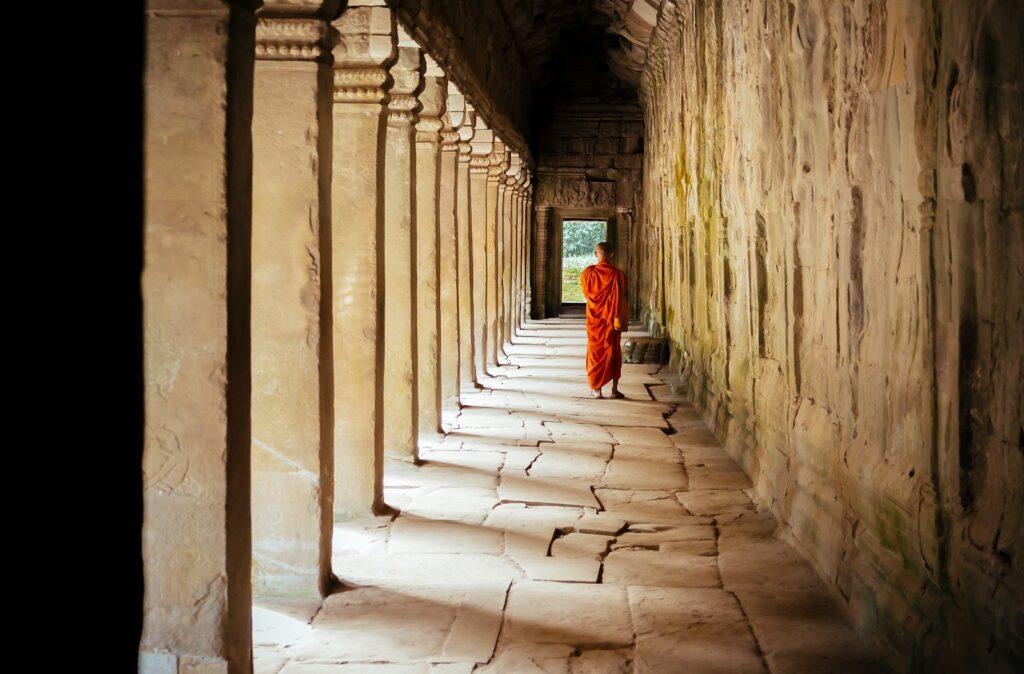
Budget considerations for your trip to Cambodia
Planning your finances is an essential part of any trip. Here’s how the time of year affects travel costs in Cambodia and tips for budget-friendly travel.
Cost variations by season
- Peak season (November to February): The most expensive time to visit. Expect higher prices for flights, accommodations, and tours owing to increased demand.
- Off-peak season (June to August): Travel costs drop significantly. You can find great deals on hotels and flights. However, be prepared for the wet season’s impact.
- Shoulder season (March to May, September to October): Prices are generally moderate. A good balance between cost and weather, especially for budget travellers.
Saving money on your trip
- Accommodation: Consider guesthouses or budget hotels. Booking in advance can secure better rates.
- Transport: Local buses and tuk-tuks are affordable options. For longer distances, consider booking buses or internal flights early.
- Food: Eat where locals eat. Street food in Cambodia is cheap and a great way to experience local cuisine.
- Sightseeing: Choose multi-day passes for places like Angkor Wat to save on entrance fees. Exploring on foot or renting a bicycle can be both economical and enjoyable.
- Currency: Understanding Cambodia’s Cambodia’s currency is important. US dollars are widely accepted, but having local currency (riel) is essential and especially useful for smaller purchases.
Additional tips
- Travel insurance: Don’t forget to factor in the cost of travel insurance. It can be a literal lifesaver in emergencies.
- Health precautions: Budget for any vaccinations or health preparations needed before your trip.
- Off-the-beaten path: Exploring less touristy areas can often be cheaper and more rewarding.
Remember, while budgeting is essential, ensuring a safe and enjoyable experience is paramount.
Always stay updated with the latest Cambodian travel advice. Keep abreast of Cambodia travel restrictions that might affect your plans.
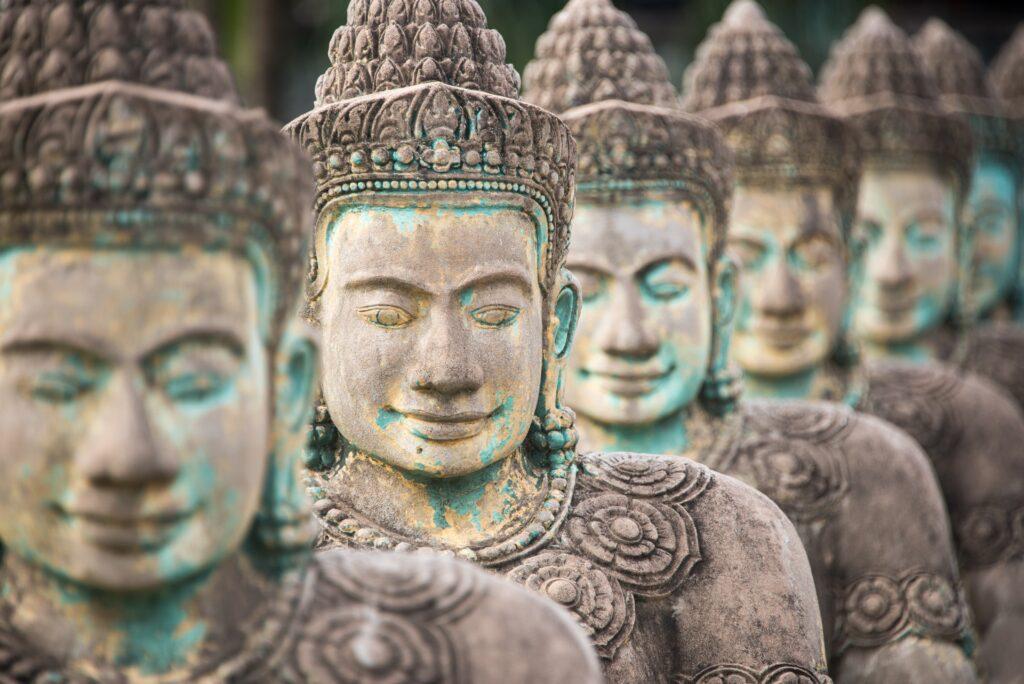
Takeaways
As our guide to the best time to visit Cambodia comes to a close, it’s clear that this vibrant country offers many experiences throughout the year.
Whether you seek the bustling energy of peak season festivals or the serene beauty of the wet season’s lush landscapes, Cambodia promises an unforgettable journey.
Summarising the best times to visit
- The dry season (November to February) is ideal for cultural explorations and temple visits.
- Beach enthusiasts will find the best conditions from November to March.
- Looking for adventure and eco-tourism? Consider the wet season (June to August) for its vibrant natural beauty.
Final thoughts
- Cambodia is more than just a destination; it’s an experience that stays with you. From the majestic temples of Angkor to the tranquil beaches of Koh Rong, each place has its unique charm.
- Embrace the local culture, cuisine, and people. Cambodia’s rich history and warm hospitality are as much a part of the journey as its scenic beauty.
- Lastly, always stay informed about Cambodia travel restrictions to ensure a safe and enriching trip.
We hope this guide helps you plan an incredible trip to Cambodia tailored to your interests and the ideal time of year.
Whether you’re a seasoned traveller or a first-time visitor, Cambodia is a land that welcomes all with open arms and endless adventures.
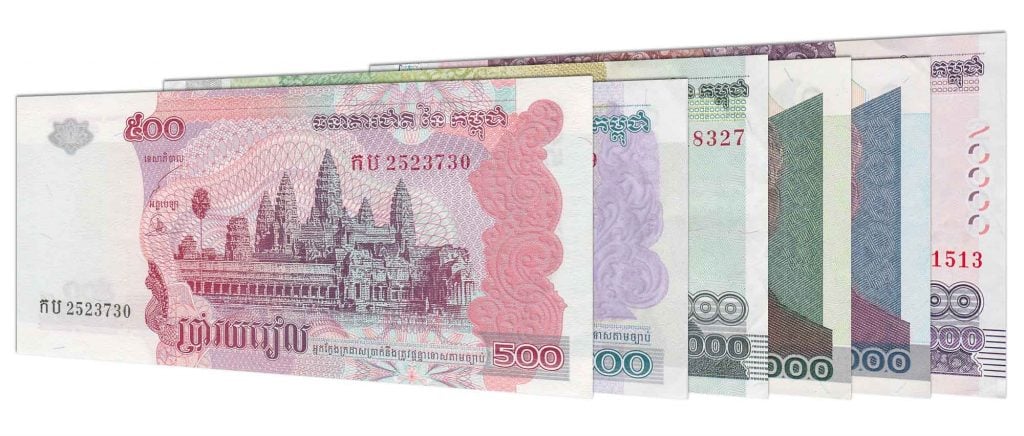
Order your Cambodian travel money with Manor FX
Get competitive rates when exchanging GBP to Cambodian riel
Preparing for your holiday to Cambodia? Let Manor FX take care of your currency needs.
The official currency in Cambodia is the Cambodian riel. When organising your journey to Cambodia, carrying a mix of US dollars (USD) and Cambodian riels (KHR) is wise.
Secure the best exchange rates online with Manor FX. Get more currency for your trip to Cambodia.
Opt for safe delivery directly to your home or workplace. Or choose to collect your Cambodian currency at our bureau near Heathrow.
Our easy-to-use online ordering system simplifies getting Cambodian riels, making it hassle-free.
Rely on Manor FX for a smooth and efficient currency exchange, enhancing your travel experience.
FAQs
What is the best month to visit Cambodia?
The best month to visit Cambodia largely depends on your preferences for weather, crowd levels, and specific experiences. However, many travellers consider the period from November to February as the ideal time to visit.
What is the rainy season in Cambodia?
The rainy season in Cambodia, also known as the monsoon season, typically runs from May to October.
What is the hottest month in Cambodia?
The hottest month in Cambodia is typically April. During this time, temperatures can soar, often reaching their peak for the year.
What is the cheapest month to go to Cambodia?
The cheapest months to travel to Cambodia are typically during the rainy season, which spans from May to October.
Do you need a visa to visit Cambodia?
Most travellers do need a visa to enter Cambodia. However, the specific requirements can depend on your nationality, the purpose of your visit, and the duration of your stay. Here are the general guidelines:
- Cambodia tourist visas. Tourist visas for Cambodia are available for most nationalities. They can be obtained either on arrival at most major airports and border crossings or online as an e-Visa before travel. The e-Visa process is generally straightforward and can be completed on the official Cambodian e-Visa website.
- Visa on arrival. If opting for a visa on arrival, ensure you have the necessary documentation. This typically includes a passport valid for at least six months, passport-sized photos, and the visa fee.
- Visa duration. Tourist visas are usually valid for up to 30 days and can often be extended.
- Exemptions. Some nationalities are exempt from visa requirements for short visits. Check the latest visa policies for your specific nationality before travelling.
- Business visas. If you’re travelling for business purposes, different visa requirements may apply.
- COVID-19 considerations. Be aware of any travel restrictions or additional requirements related to COVID-19. These can change, so checking the most current information is essential.
Always check the most up-to-date travel advisories and visa requirements from a reliable source. Contact your home country’s foreign affairs department or the Cambodian embassy before your trip.
What are the best places to visit in Cambodia?
Cambodia is a country rich in culture, history, and natural beauty. Here are some of the best places to visit:
- Angkor Wat and Angkor Archaeological Park. The iconic temple complex, one of the largest religious monuments in the world, is a must-visit. The surrounding park includes numerous ancient temples like Bayon, Ta Prohm, and Angkor Thom.
- Phnom Penh. The capital city offers a mix of the modern and traditional. The Royal Palace, Silver Pagoda, and the National Museum are key attractions. The Tuol Sleng Genocide Museum and the Killing Fields offer sobering insights into the country’s recent history.
- Siem Reap. A popular tourist town as the gateway to Angkor Wat. Siem Reap has a vibrant night market, excellent dining, and cultural shows.
- Sihanoukville and Coastal Islands. Enjoy Sihanoukville’s relaxed atmosphere, beautiful beaches, and nearby islands like Koh Rong and Koh Rong Samloem.
- Battambang. Known for its colonial architecture and the nearby Bamboo Train. Battambang also offers access to rural villages and ancient temples.
- Kampot and Kep. These quiet coastal towns are famous for their pepper plantations and fresh seafood. Kep also has a charming national park and a crab market.
- Tonle Sap Lake. Southeast Asia’s largest freshwater lake is home to floating villages and offers unique insights into the local way of life. The lake’s size varies dramatically with the seasons.
- Mondulkiri Province. Known for its rolling hills, waterfalls, and the Elephant Valley Project, a sanctuary for retired working elephants.
- Kratie. A riverside town known for being one of the best places to see the rare Irrawaddy dolphins in the Mekong River.
- Preah Vihear. An ancient Hindu temple atop a cliff in the Dângrêk Mountains offers stunning views.
Each of these destinations offers a unique glimpse into the diverse fabric of Cambodia. From ancient ruins and natural wonders to bustling cities and serene beaches.